| |
Native
American Artifacts & Art
 I'm creating these
pages as a way to catalogue my collection and learn about point typology.
It's also the place where I'll be recording the notes I take while doing
research on ancient America. These points are not for sale though I am
occasionally interested in purchasing old collections especially if they are
personal finds. Personal recollections about the finding of the
artifacts are definitely of interest to me. Many times the story is more
interesting than the point itself. I'm creating these
pages as a way to catalogue my collection and learn about point typology.
It's also the place where I'll be recording the notes I take while doing
research on ancient America. These points are not for sale though I am
occasionally interested in purchasing old collections especially if they are
personal finds. Personal recollections about the finding of the
artifacts are definitely of interest to me. Many times the story is more
interesting than the point itself.
Rob Horne
Historic Points
Pre-Columbian to modern times |
Mississippian
Points
400 B.P. to 1300 B.P. |
Woodland Points
1300 B.P. to 3,000 B.P. |
Late Archaic Points
3,000 B.P. to 5,000 B.P. |
Mid Archaic
Points
5,000 to 6,500 B.P. |
Early
Archaic Points
6,500 to 9,000 B.P. |
Paleo Points
9,000 B.P. to 11,500 B.P. |
|
Stone Tools - Celts, Net weights, Axes, Banner Stones |
|
Dalton's |
Pendants & Gorgets |
|
Ex-Stagecoach
Lane Collection |
Ex-Stangland
Collection |
Ex-Lillian
Martel Collection |
Point Notes |
| |
|
Musical Instruments |

Historic Points
Pre-Columbian to modern times
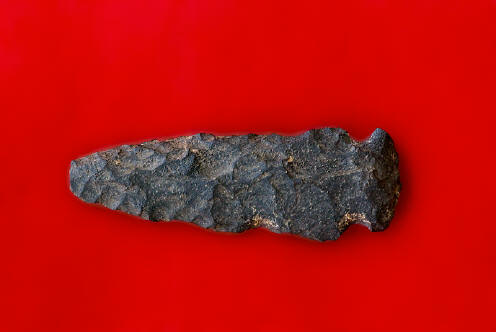 |
Anasazi/Hohokam Point
From the Sonora Desert
L 2.51" W .90"
Anasazi, Ancient
Pueblo People or Ancestral Puebloans were a prehistoric Native American
culture centered on the present-day Four Corners area of the Southwest
United States, noted for their distinctive pottery and dwelling construction
styles. Archaeologists still debate when a distinct culture emerged, but the
current consensus, based on terminology defined by the Pecos Classification,
suggests their emergence around 1200 BC, during the Basketmaker II Era.
The term Hohokam, borrowed from the Akimel O'odham, is used to define
an archaeological culture that existed from the beginning of the current era
to about the middle of the 15th century AD. As an abstract construct this
culture was centered on the middle Gila River and lower Salt River
drainages, in what is known as the Phoenix basin.
While the names
Anasazi/Hohokam sell better on Ebay, I would be more likely to label this a
San Pedro or variant of some sort.
Overstreet 10 p.877.
Actually I don't see any listed for this area that closely resemble this
point.
|

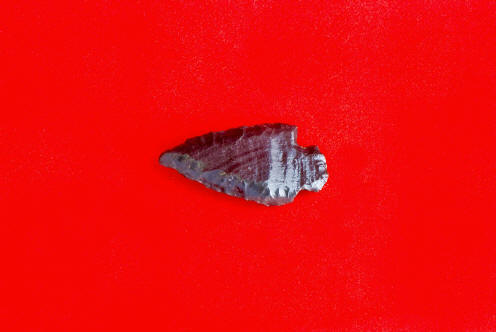 |
Borax Lake ?
(Not likely)
Early Archaic, 8000 - 5000 B.P.
L 1.21" W .61"
Obsidian
Provenance: Found as a surface find by Catherine Horne
of Descanso. Off highway 395 north of Mono Lake.
Note: This corner notched head
has a small piece from one of the barbs missing
Grinding base reduction?
Beveled
N. California into S.
Oregon and occasionally into W. Nevada. This type has an elongated,
triangular blade when pristine with a wide, approximately square stem. Stem
sides are often ground. Bases are straight to slightly convex. - Overstreet 10 p. 975
|

|
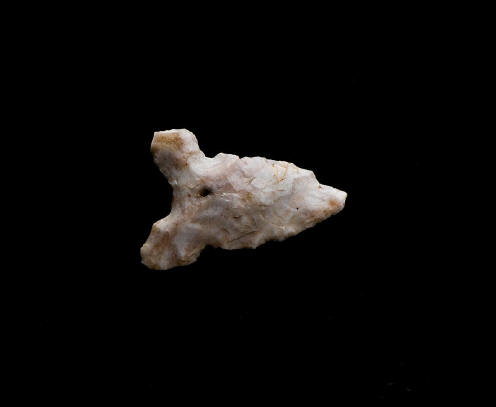
|
Buck Taylor
Classical to Historic Phase, 600 - 200 B.P.
L 3/4" W 1/2"
A small triangular, tri
notched arrow point including a deep basil notch. Part of the Pueblo
Side Notched cluster. - Overstreet 10 p.
824
Reportedly found in Arizona
|

|
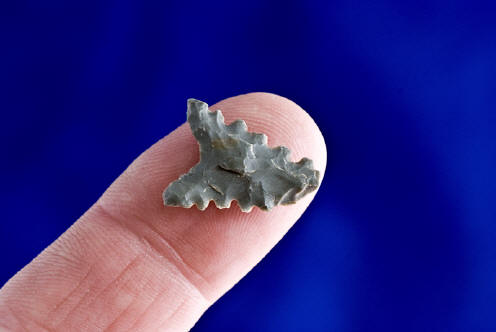
|
Point Type:
Canali˝o
Triangular Arrow Point
Length: 3/4 inch
Age: 200 to 800 years old
Material: Felsite
Provenance: Found as a surface find during the summer of 2008 on private
land north of Descanso, California by Rob Horne of Descanso.
Note: The tip of this point is missing. In its original, undamaged state, it
was probably 35 to 40% longer than seen above, placing it at over one inch
in length when made by the aboriginal.
Collection of: Rob Horne
Information and photo below provided by
Steve Stangland
of AACA
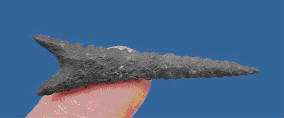
Although probably not as elongated as this
arrowpoint, the point seen on the left, in its original form, would
have looked similar to this complete Canalino point.
Kumeyaay Indians - Our valley was the
site of their seasonal campsites during the hot summer months as they would
travel from the eastern desert to collect acorns and avoid raiding parties
from the Yuma area Indians.
Most sources say that the Kumeyaay territory extended south to Baja
California and east to the Imperial Valley. |

|
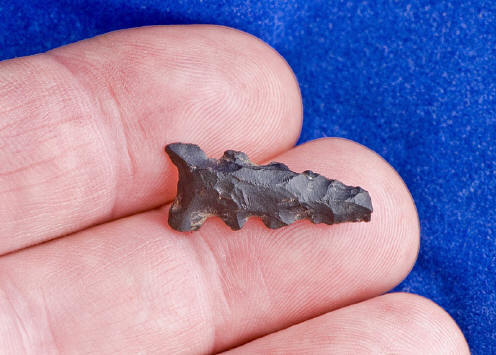
|
Point Type:
Canali˝o Arrow Point
L .93"
W .40"
Age: 200 to 800 years old
Material: Felsite, chert
Provenance: Found as a surface find 1999 on private
land north of Descanso, California by Rob Horne
of Descanso. A
small size, thin, triangular arrow point with a shallow to deep concave
base. Some are serrated. Also known as Coastal Cottonwood. - Overstreet 10 p. 978 |

|
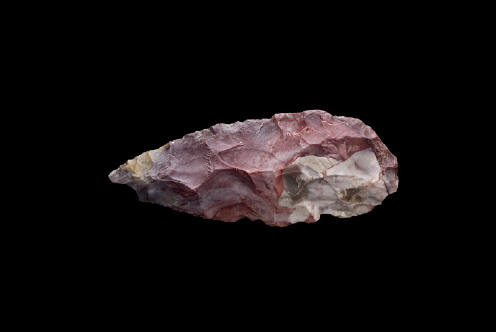 |
Cottonwood Leaf
Desert Traditions Classic/Historic Phases 700 - 200 B.P.
L 2" W 3/4"
Overstreet 10 p. 832 - Arizona and westward into
California and Nevada. A small, thin, leaf shaped arrow point that
resembles a long tear-drop. The base is rounded.
This point was reportedly
found in Arizona
|

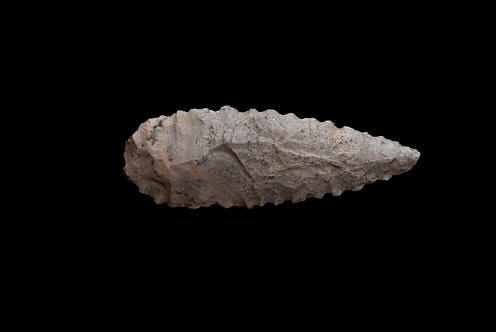 |
Cottonwood Leaf
Desert Traditions Classic/Historic Phases 700 - 200 B.P.
L 2" W 3/4"
Overstreet 10 p. 832 - Arizona and westward into
California and Nevada. A small, thin, leaf shaped arrow point that
resembles a long tear-drop. The base is rounded.
This point was reportedly
found in Arizona
|

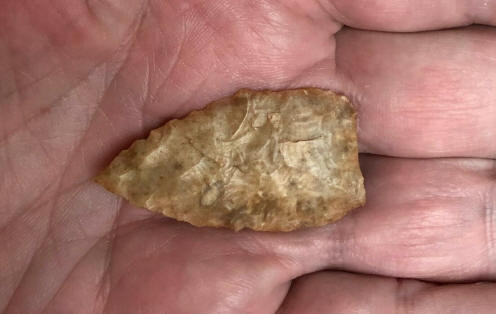 |
Cottonwood Leaf
Desert Traditions Classic/Historic Phases 700 - 200 B.P.
L 1-5/8" W 15/16"
_small.jpg)
COA Jeff Baker - G10
Overstreet 10 p. 832 - Arizona and westward into
California and Nevada. A small, thin, leaf shaped arrow point that
resembles a long tear-drop.
Mendoceno County, Calif.
|

|
 |
Cottonwood Triangle
Desert Traditions Classic/Historic
Phases 700 - 200 B.P.
L 1 1/4" W 9/16" Arizona
Overstreet 10 p. 832 - Arizona and westward into
California and Nevada. A small thin triangular arrow point with a
straight to slightly convex basal edge.
This point was reportedly
found in Arizona |

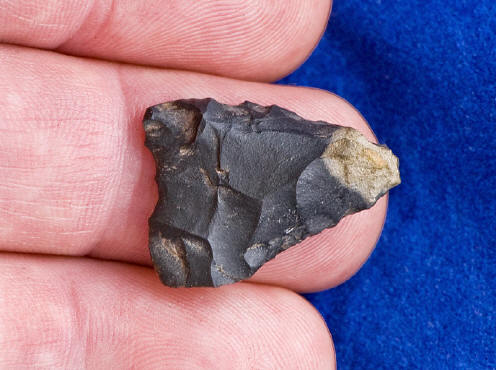 |
Cottonwood Triangle -
Possible exhausted Canali˝o
Desert Traditions Classic/Historic
Phases 700 - 200 B.P.
L .95"
W .71"
Arizona and westward into
California and Nevada. A small thin triangular arrow point with a
straight to slightly convex basal edge.
Point Type:
Unifaced
Triangular Arrow Point
Provenance: Found as a surface find November 2008 on private
land north of Descanso, California by Rob Horne
of Descanso.
Overstreet 10 p. 832 |

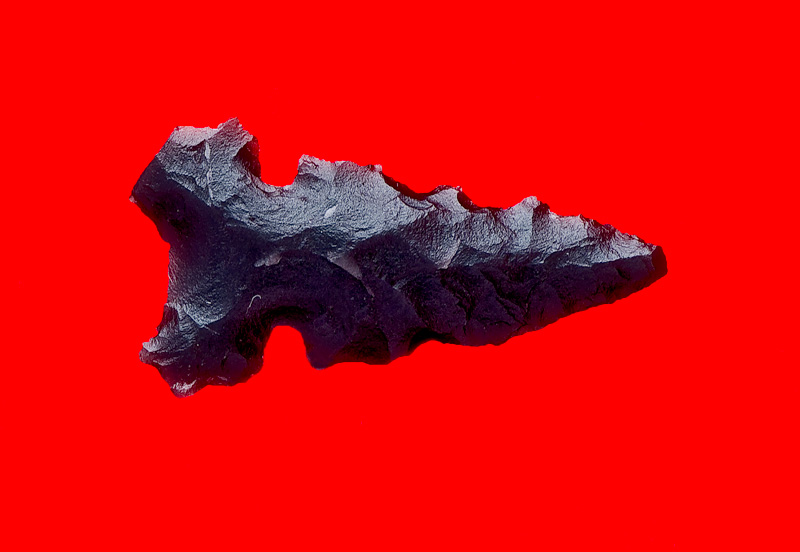 |
Desert Side Notch, Sierra Side Notch ?
Unknown Origins
L 1.14" x W .6" |

 |
Desert Sierra
Side Notched
Classic to Historic, 700 - 200 B.P.
L .91" W
.48
Desert Sierra point from
an old collection found in the 1950's.
Chert - A Great Basin point. No earlier than 1100 to 1200 A.D. to historic
and modern age.
Great Basin Westward. A small size, thin
triangular side and basal notched arrow point with distinctive basal pointed
barbs and basal notch. -
Overstreet 10 p. 1011 |

Back to Top
| |
|
Useful
Resources
|
|
|

Authentic
Artifact
Collectors
Association
______
Overstreetid.com
The Official Overstreet Indian
Arrowhead Identification Online Database
______
|
|
|
|
|
|
|